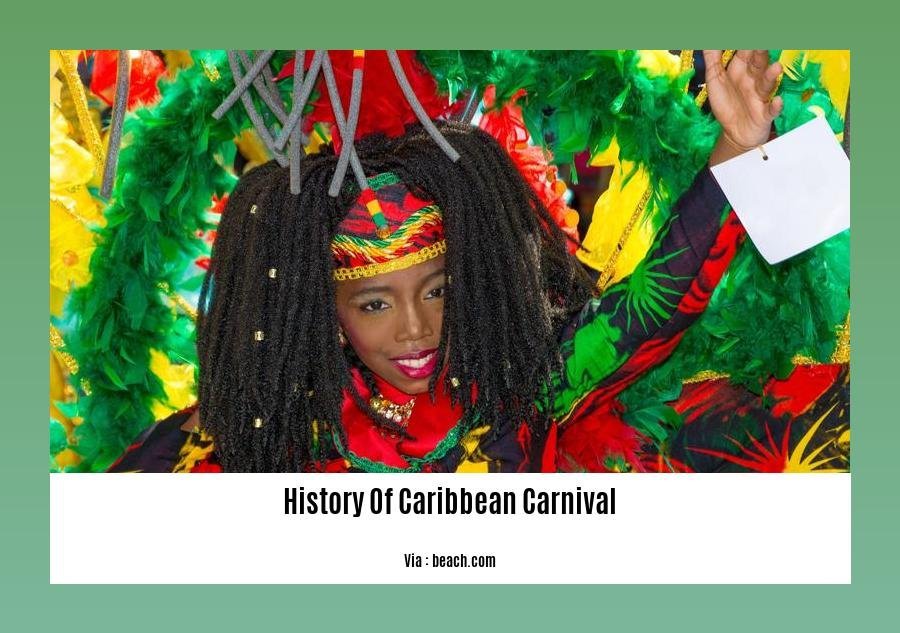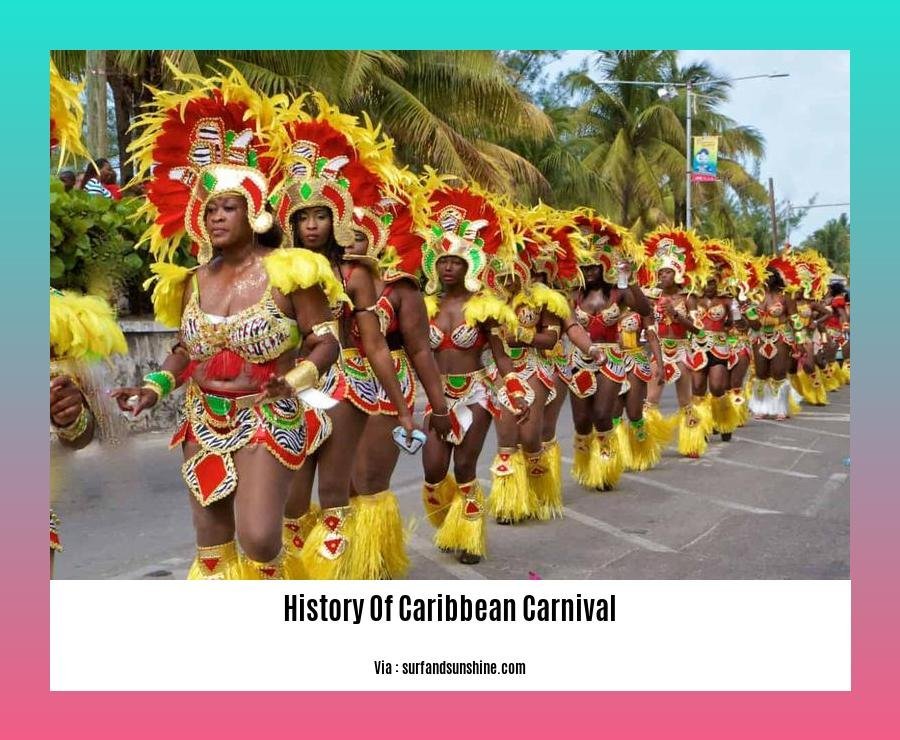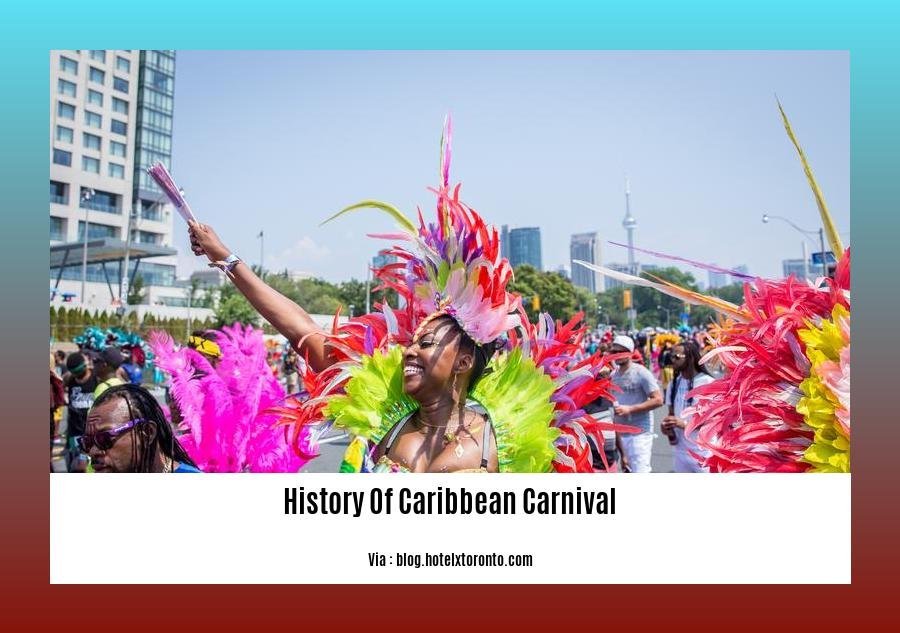In “Tracing the Rhythms of Resistance and Resilience: A Journey Through the History of Caribbean Carnival,” we embark on a captivating voyage into the vibrant world of Caribbean carnival, exploring its rich tapestry of origins, evolution, and enduring impact on Caribbean culture. From its humble beginnings as a form of resistance against colonial rule to its transformation into a global celebration of creativity, resilience, and cultural exchange, this article delves into the historical roots, social significance, and contemporary relevance of this captivating tradition.
Key Takeaways:
Caribbean Carnivals originated in 1834, merging traditions like the Canboulay and the European Mardi Gras masquerade post-slavery abolition.
The Yoruba people from Nigeria significantly influenced Caribbean Carnival celebrations with their rich culture.
History of Caribbean Carnival

The history of Caribbean carnival is a captivating tapestry of diverse influences, showcasing the resilience and creativity of the Caribbean people. Emerging after the abolition of slavery in 1834, carnival coalesced traditions like the Canboulay and European Mardi Gras masquerade.
Tracing the Rhythms of Resistance:
- Canboulay: A vibrant celebration with African roots, characterized by drumming, dancing, and colorful costumes, emerged as a form of resistance against oppressive plantation life.
- Pierrot Grenade: A costumed character symbolizing the defiance of enslaved people, often wielding a whip or stick to challenge authority.
Echoes of African Legacy:
- Yoruba Influence: The Yoruba, a significant ethnic group from Nigeria, brought their vibrant culture to the Caribbean, leaving an indelible mark on carnival celebrations.
- Costumes and Rituals: Yoruba spiritual traditions, such as Egungun masquerades, influenced the elaborate costumes and rituals seen in many Caribbean carnivals.
Evolution and Transformation:
- Colonial Influences: European colonizers introduced their own traditions, such as masquerade balls and street parades, which blended with African and indigenous elements to create a unique Caribbean carnival style.
- Contemporary Expressions: Modern-day carnivals have evolved into grand spectacles, showcasing stunning costumes, energetic music, and captivating performances, attracting tourists worldwide.
A Celebration of Freedom and Expression:
- Cultural Showcase: Carnival serves as a platform for Caribbean artists, musicians, and designers to showcase their talent, fostering a sense of pride and unity within the community.
- Social Commentary: Carnival often incorporates elements of social and political commentary, allowing participants to express their concerns and aspirations through music, costumes, and performances.
The history of Caribbean carnival is an ongoing journey, continuously evolving and adapting to reflect the vibrant spirit of the Caribbean people. It stands as a testament to their resilience, creativity, and ability to transform adversity into artistry.
- Ever wonder how Callaway irons came to be? Dive into the depths of history to trace their evolution and triumph in the golfing world. History of Callaway Irons
- Want to unravel the hidden narrative of caps? Embark on an exciting journey through time to uncover their profound impact on cultures and civilizations. History of Caps
- Experience the captivating history of Carnatic music as it weaves its enchanting melodies and rhythms through the tapestry of time, leaving an indelible mark on the world’s musical landscape. History of Carnatic Music
Carnival as a Platform for Resistance and Cultural Expression, Challenging Colonial Power Structures, and Asserting Caribbean Identity
Carnival is a potent expression of Caribbean resistance against oppressive colonial regimes and a celebration of diverse cultural identities.Emerging from the islands’ complex history of slavery, colonialism, and cultural fusion, carnival became a platform to challenge authority, promote cultural pride, and assert a unique Caribbean identity.
Carnival’s Origins: Rooted in Resistance
History reveals that Caribbean carnival traces its roots to the vibrant traditions and rituals of Africa and the indigenous peoples of the Caribbean. Enslaved Africans brought their cultural traditions and practices, including music, dance, and masquerade, which formed the foundation of carnival celebrations.
Canboulay and Pierrot Grenade: Symbols of Defiance
In Trinidad and Tobago, the pre-Lenten festival of Canboulay was a pivotal moment in carnival’s history. With its African and French Creole influences, Canboulay featured masqueraders adorned in colorful costumes and elaborate headdresses, challenging the colonial authority. Another symbol of resistance was the character Pierrot Grenade, who, wielding a whip or stick, embodied defiance and challenged societal norms.
The Fusion of Cultures: A Vibrant Tapestry
As carnival evolved over centuries, it assimilated various cultural influences, blending African rhythms with European traditions like Mardi Gras. The Yoruba culture brought vibrant costumes, intricate beadwork, and masquerade traditions, further enriching the carnival’s cultural tapestry.
Modern-Day Carnival: A Global Spectacle
Today, Caribbean carnivals have transformed into grand spectacles that attract tourists from around the world, showcasing the region’s artistic prowess and cultural diversity. From the vibrant parades of Trinidad and Tobago to the pulsating rhythms of Barbados’ Crop Over Festival, carnival has become a global symbol of Caribbean creativity and resilience.
Key Takeaways:
- Carnival originated from the fusion of African and indigenous cultural traditions in the Caribbean.
- Enslaved Africans used carnival as a platform to resist colonial oppression and celebrate their cultural identities.
- Canboulay and Pierrot Grenade were iconic symbols of defiance and resistance in early carnival celebrations.
- Carnival has evolved into a global spectacle that showcases the artistic expressions, vibrant costumes, and rhythmic music of the Caribbean.
Sources:
- Leeds Beckett University: Caribbean Carnival – The Best in The World
- HOUSTON CARIBBEAN FESTIVAL 2023 | Events & More – Carnivaland
Diverse manifestations of carnival across the Caribbean, exploring variations in music, costumes, and dance styles

Get ready to dive into the vibrant kaleidoscope of Caribbean Carnival, where each island pulsates with its unique rhythm, costuming, and dance style. From the high-energy soca of Trinidad and Tobago to the sensual cadence of Haitian konpa, the Caribbean Carnival is a testament to the region’s rich cultural tapestry.
Music: A Symphony of Rhythms
Trinidad and Tobago: The pulsating beat of soca music, a fusion of calypso and Indian rhythms, sets the tempo for Trinidad’s Carnival. Steelpan bands fill the air with infectious melodies, while revelers sway to the hypnotic rhythm.
Haiti: Haitian Carnival, known as Kanaval, echoes with the captivating rhythm of konpa, a fusion of Haitian rara and African beats. Dancers move to the infectious tempo, their bodies swaying to the irresistible groove.
Jamaica: Jamaica’s Carnival, a more recent addition to the Caribbean Carnival scene, pulsates with the infectious reggae beat. Dancehall rhythms blend with traditional Jamaican music, creating a uniquely Jamaican Carnival experience.
Costumes: A kaleidoscope of Colors
Trinidad and Tobago: Trinidad’s Carnival costumes are a feast for the eyes, a riot of feathers, sequins, and vibrant colors. Masqueraders parade in elaborate costumes, each a testament to the creativity and artistry of the Caribbean people.
Barbados: Barbadian Carnival costumes showcase the island’s African heritage, with intricate beadwork and colorful fabrics adorning revelers. The “Grand Kadooment” parade on “Crop Over” day is a kaleidoscope of vibrant costumes and pulsating music.
Dominican Republic: The Dominican Republic’s Carnival, known as “Carnaval Dominicano,” features colorful costumes inspired by African and Taino traditions. Revelers don intricate masks and flamboyant costumes, creating a mesmerizing spectacle.
Dance: A fusion of cultures
Trinidad and Tobago: The dance styles of Trinidad’s Carnival are as diverse as its music, with each region boasting its unique moves. From the energetic “wining” to the graceful “chip,” the dances reflect the island’s vibrant spirit.
Barbados: Barbadian Carnival dances showcase the island’s African heritage, with energetic waist movements and intricate footwork. The “daggering” dance, a sensual and provocative style, is a highlight of the Barbadian Carnival.
Jamaica: Jamaica’s Carnival dances are a fusion of African and Caribbean influences, with a strong emphasis on hip movements and body isolations. The “daggering” dance, popular in Jamaica, exudes sensuality and energy.
Key Takeaways:
- The Caribbean Carnival is a diverse and dynamic celebration, with each island showcasing its unique music, costumes, and dance styles.
- Music varies from the high-energy soca of Trinidad and Tobago to the sensual konpa of Haiti and the infectious reggae of Jamaica.
- Costumes are a riot of colors and creativity, with each island displaying its unique cultural heritage through elaborate designs.
- Dance styles are a fusion of African, Caribbean, and European influences, creating a mesmerizing spectacle of movement and rhythm.
- The Caribbean Carnival is a celebration of unity, creativity, and resilience, bringing people together to revel in the rich cultural heritage of the Caribbean.
Relevant Sources:
- Carnival in the Caribbean – A Cultural Celebration of Music, Dance, and Costumes
- The Diverse Manifestations of Carnival Across the Caribbean
Enduring Impact of Carnival on Caribbean Culture: Shaping Artistic Expression, Community Building, and Tourism
In the vibrant tapestry of Caribbean culture, carnival stands as a testament to the region’s enduring spirit of resistance, resilience, and celebration. From its humble origins as a post-emancipation celebration to its transformation into a global phenomenon, carnival has left an indelible mark on the Caribbean identity. Join us on a journey to explore the profound impact of carnival on the region’s artistic expression, community building, and tourism.
A Canvas of Creativity: Carnival’s Artistic Legacy
Carnival is an explosión of artistic expression, where vibrant colors, mesmerizing costumes, and infectious rhythms converge to create a visual and sonic spectacle. It’s a platform for local artisans, designers, and musicians to showcase their talent, pushing the boundaries of creativity and innovation. The elaborate costumes, often adorned with feathers, beads, and intricate designs, are not just mere garments; they are expressions of cultural pride and artistic prowess.
Fostering Community Bonds: Carnival’s Unifying Power
Beyond its artistic allure, carnival serves as a powerful force for community building in the Caribbean. It transcends social divides, bringing people from all walks of life together in a shared celebration of culture and heritage. Carnival is a time for communities to unite, collaborate, and create something truly extraordinary. It fosters a sense of belonging and togetherness that extends beyond the duration of the festival, strengthening the social fabric of Caribbean societies.
A Catalyst for Tourism: Carnival’s Economic Impact
Carnival has emerged as a significant economic driver for the Caribbean region. The allure of these vibrant festivals attracts tourists from around the world, eager to immerse themselves in the spectacle and revelry. The influx of visitors during carnival season generates revenue for local businesses, creating employment opportunities and boosting economic growth. The tourism industry, in turn, provides a platform for local artisans and entrepreneurs to showcase their products and services, further contributing to the sustainability of Caribbean economies.
Key Takeaways:
- Carnival’s artistic legacy shines through its vibrant costumes, mesmerizing performances, and infectious rhythms, showcasing the region’s rich cultural heritage.
- Carnival fosters community bonds by uniting people from diverse backgrounds in a shared celebration of culture, promoting a sense of belonging and togetherness.
- Carnival serves as a catalyst for tourism, attracting visitors from around the world and generating revenue for local businesses, contributing to economic growth and sustainability.
References:
- Carnival in the Caribbean
- The Economic Impact of Carnival in the Caribbean
FAQ
Q1: What are the origins of Caribbean Carnival?
A1: Caribbean Carnival emerged in the 1830s in Trinidad and Tobago, after the abolition of slavery, combining African and European traditions. It was influenced by the Yoruba culture brought by enslaved Nigerians and the Canboulay and European Mardi Gras masquerade.
Q2: How did Carnival become a platform for resistance and resilience in the Caribbean?
A2: Carnival served as a platform for resistance and resilience by providing a space for enslaved and marginalized communities to express their cultural identity and challenge the power structures of colonialism and oppression. It allowed them to celebrate their heritage, affirm their existence, and find solace and strength in their shared experiences.
Q3: What are some of the unique cultural expressions showcased during Caribbean Carnival?
A3: Caribbean Carnival is renowned for its vibrant and diverse cultural expressions, including elaborate costumes, energetic music, and captivating dance performances. It showcases a fusion of African, European, and Indigenous influences, reflecting the region’s rich cultural heritage.
Q4: How has Carnival evolved over time, and what are some of the contemporary themes and issues it addresses?
A4: Carnival has undergone constant reinterpretations throughout history, reflecting the changing social and political landscape of the Caribbean. Contemporary themes addressed in Carnival include social justice, cultural identity, gender equality, and environmental sustainability, demonstrating its continued relevance and ability to engage with current issues.
Q5: What is the significance of Carnival in shaping Caribbean identity and fostering a sense of regional unity?
A5: Carnival plays a crucial role in shaping Caribbean identity by providing a platform for cultural expression, creativity, and celebration. It fosters a sense of regional unity by bringing together diverse communities across the Caribbean to share their cultural heritage and celebrate their shared experiences, promoting a sense of belonging and solidarity.
- Mastering Leader in Spanish: The Complete Guide - April 19, 2025
- Uncovering Surprising Parallels: England Size Compared to US States - April 19, 2025
- Old Mexico Map: Border Shifts 1821-1857 - April 19, 2025
















